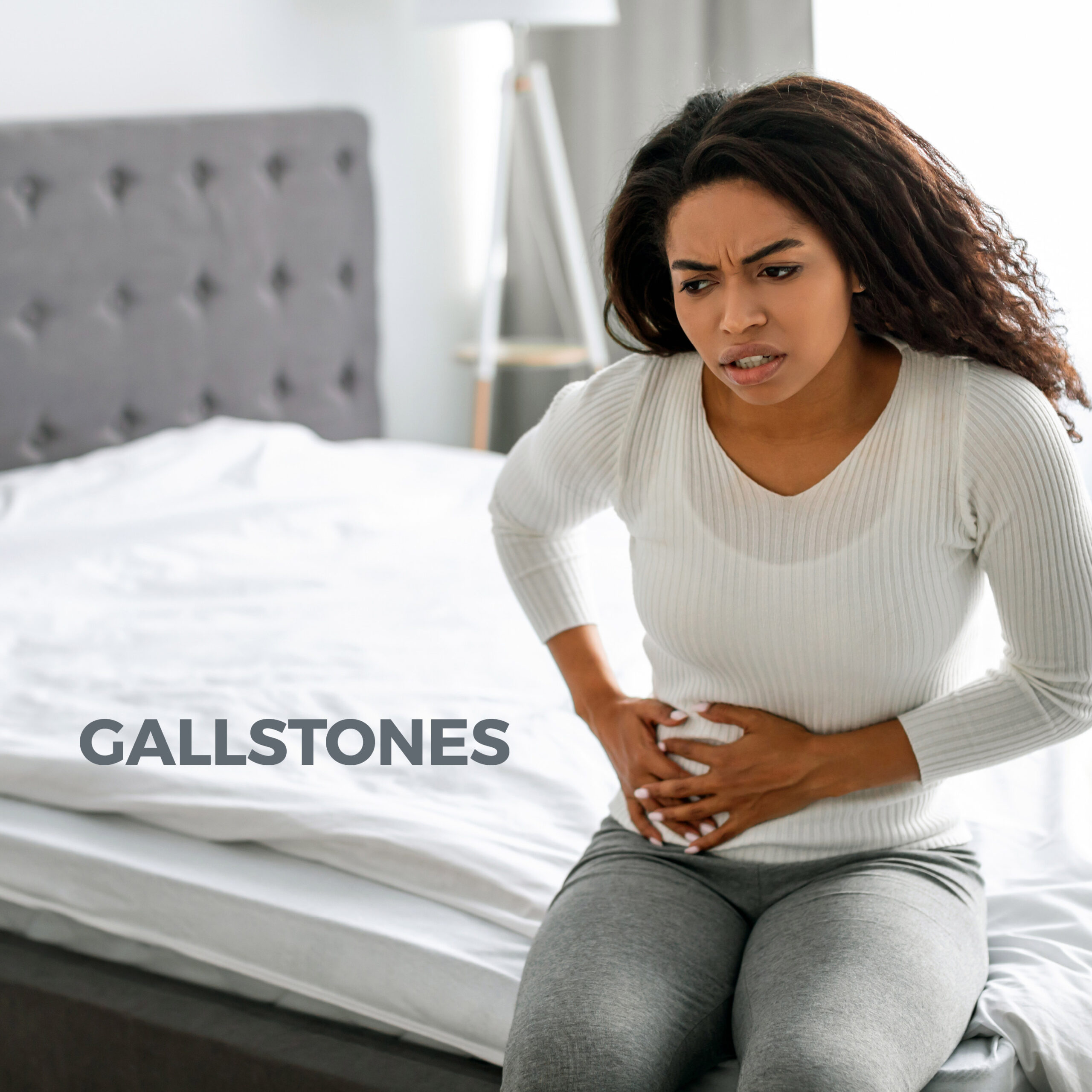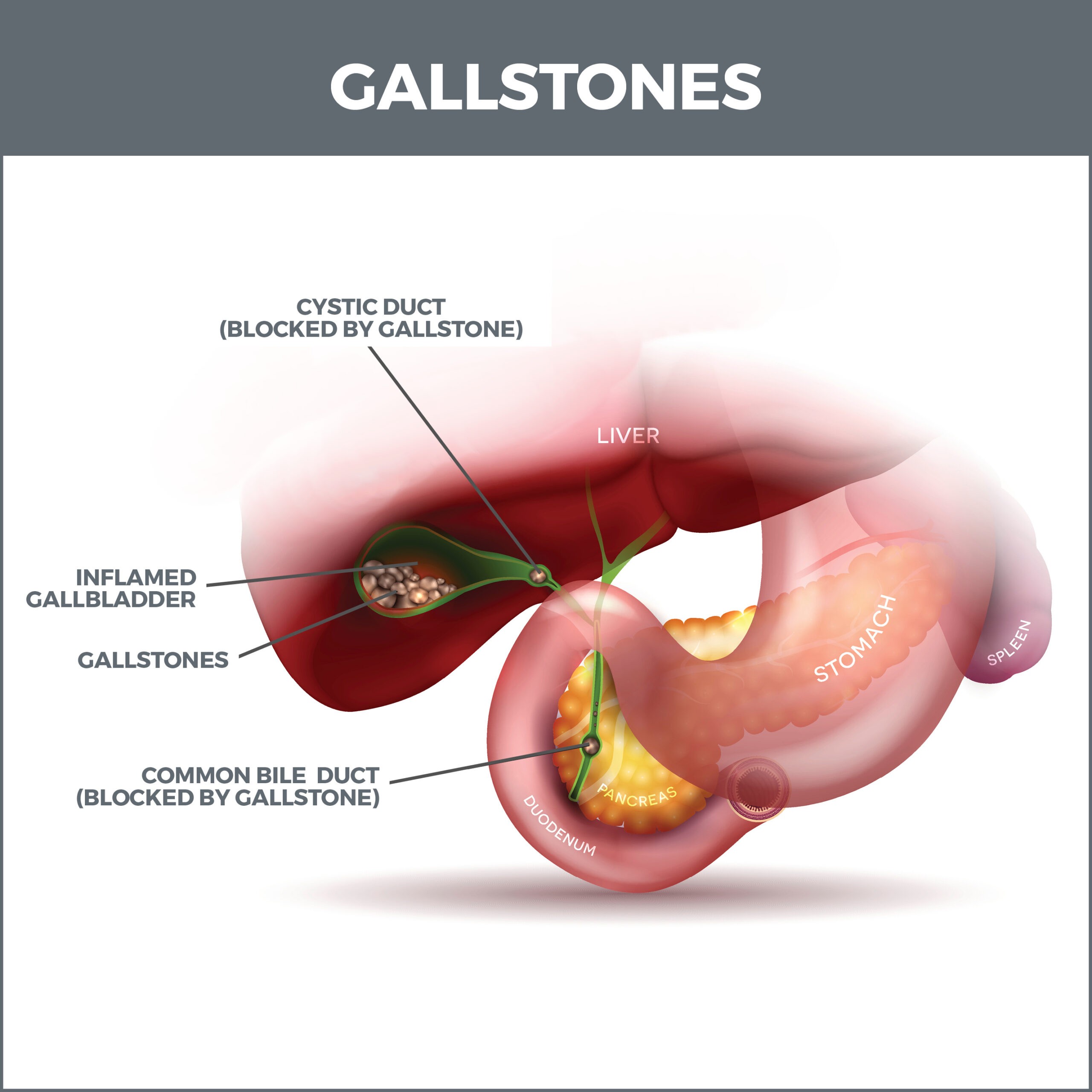
Gallstones
If you’re experiencing intense abdominal pain, you may have gallstones. Gallstones affect more than 20 million Americans, and approximately 14 million of those are women. They form in an organ called the gallbladder, which aids in digestion. These stones can either be extremely painful or not have any symptoms.
What is the Gallbladder?
Your gallbladder is a small, pear-shaped organ that sits under your liver. Its purpose is to store and release bile, a liquid produced by the liver that aids in the digestion of fatty foods. Bile combines cholesterol, bile salts, and bilirubin. Bilirubin is a waste material that breaks down protein in red blood cells.
Before a meal, the gallbladder is filled with bile. As you begin eating, the gallbladder squeezes bile into the small intestine, where the substance combines with food that needs to be digested.
What Are Gallstones?
Gallstones are hard deposits of digestive fluids that become lodged in your gallbladder. They can be as small as a grain of rice or as large as a golf ball. They can be hard, soft, smooth, or rough. There can be many or just one.
When stones are in the gallbladder, it’s called cholelithiasis. When one is in the bile ducts, it’s called choledocholithiasis.
While some stones cause pain, others go unnoticed until they are spotted by coincidence during testing for another unrelated condition. These are called silent gallstones. Up to 80% of people have gallstones and are unaware of it. Unnoticed or not, the longer a gallstone goes undetected, the more harmful it can become.

Types of Gallstones
There are two types of gallstones:
- Cholesterol Stones – These stones are yellow-green and made of hardened cholesterol. They comprise 80 percent of all gallstones in the United States.
- Pigment Stones – These small, dark stones form when too much bilirubin and calcium are in the bile.
Some stones are a combination of each.
You can get gallstones even if you watch what you eat. For example, if you follow a particularly low-fat diet, the gallbladder has an inadequate amount of fat to digest. Then the gallbladder operates less frequently, giving cholesterol more time to harden.
What Are Risk Factors for Gallstones?
The following are potential risk factors:
- Estrogen – Excess estrogen from hormone replacement, pregnancy, or birth control pills.
- Gender – Women are twice as prone to stones as men.
- Obesity – Obesity, particularly in women, is a risk factor.
- Age – People over 60 are more prone to stones than younger people.
- Rapid Weight Loss – Rapid weight loss can prompt the liver to secrete too much cholesterol into the bile, leading to gallstones.
- Medications that Lower Cholesterol – Although it seems contradictory, drugs that lower cholesterol in the bloodstream can increase the amount secreted into bile, making stones more likely.
- Fasting – Fasting slows gallbladder function, causing the bile to become inundated with cholesterol.
- Being Sedentary.
- Eating a Low-Fiber Diet.
- Blood Disorders Such as Sickle Cell Anemia.
- Cirrhosis.
- Crohn’s Disease.
Once you’ve had gallstones, you’re likely to have more.
Causes of Gallstones
Although research is inconclusive, stones may form because:
- Your Gallbladder Doesn’t Completely Empty: If this happens, your bile can become highly concentrated, prompting gallstone formation.
- Your Bile Contains Too Much Bilirubin: Cirrhosis, biliary tract infections, and blood disorders can make your liver produce too much bilirubin, leading to gallstone formation.
Your Bile Contains Too Much Cholesterol: When your body cannot dissolve cholesterol, the excess cholesterol can form stones.

Complications of Gallstones
Some complications can arise from gallstones, including:
- Common Bile Duct Blockage – If stones block the bile ducts from your gallbladder to your liver or your small intestine, it can cause intense pain, bile duct infection, or jaundice.
- Gallbladder Inflammation (acute cholecystitis) – This condition occurs when a stone obstructs your gallbladder and prevents it from emptying. As a result, it causes fever and constant pain. Immediate treatment is needed, so the organ doesn’t rupture.
- Pancreatic Duct Blockage – The pancreatic duct runs from the pancreas to the common bile duct and into the duodenum (the first part of the small intestine). Digestive juices flow through the pancreatic duct. If a gallstone blocks this duct, it can cause inflammation of the pancreas (pancreatitis). This condition causes continuous, severe pain and requires hospital treatment.
- Gallbladder Cancer – Although this disease is rare, gallstones increase your risk of developing it.
How Are Gallstones Diagnosed?
There are many procedures for diagnosing gallstones:
- Blood Tests – Blood tests can indicate infection, pancreatitis, jaundice, or other complications resulting from stones.
- Abdominal Ultrasound – An abdominal ultrasound, also called a sonogram, is an imaging technique utilizing sound waves that create pictures of the inside of your body. You may have seen it being used to produce images of a fetus in the uterus. In much the same way that it detects and produces images of the fetus, it can show a view of any gallstones present in your body.
- Endoscopic Ultrasound – Endoscopic ultrasound can detect small gallstones that an abdominal ultrasound may not. During this procedure, your doctor passes a thin tube called an endoscope from your mouth through your digestive tract. The end of the tube contains a small ultrasound device that emits sound waves and provides a detailed image of the stones.
- Magnetic Resonance Cholangiopancreatography – Magnetic resonance cholangiopancreatography (MRCP) is a particular type of MRI (Magnetic Resonance Imaging). This device uses a combination of radioactive energy and powerful magnets to reveal abnormalities of your gallbladder, bile ducts, and pancreas.
- Cholescintigraphy – Cholescintigraphy (HIDA scan) determines whether your gallbladder has blockages or leaks. During this procedure (also called a hepatobiliary scintigraphy), your doctor injects a radioactive tracer into a vein your arm, which takes pictures as it travels through your bloodstream to your liver, where the bile-producing cells take it up. The tracer then travels with the bile into your gallbladder and through your bile ducts to your small intestine.
Treatment
There are surgical and non-surgical procedures for treating gallstones:
- Ursodeoxycholic Acid – If someone cannot undergo general anesthesia, gallstones composed of cholesterol can be dissolved with ursodeoxycholic acid (a naturally occurring bile acid). It can take up to two years to eliminate stones this way, and they may come back once you stop taking the medication.
- Endoscopic Retrograde Cholangiopancreatography – ERC is performed if a patient can’t tolerate ursodeoxycholic acid or surgery. A fiber-optic camera is passed from the patient’s mouth through the gallbladder during this procedure. A heated wire spreads the bile duct’s opening so that your doctor can access stones.
Many people suffering from gallstones have their gallbladder removed since it isn’t an essential organ. This method is the most recommended option for gallstones.
Cholesterol gallstones may be treatable with non-surgical procedures. However, the same is not true for pigment gallstones, which must be surgically removed.
Your doctor will perform one of two surgeries:
- Laparoscopic Cholecystectomy – Laparoscopic cholecystectomy is the most common gallstone surgery. A thin tube called a laparoscope is passed through a small cut in your abdomen during the operation. The tube is outfitted with a light, camera, and surgical instruments. Then, the organ is removed by another small cut. Usually, you can go home the same day.
- Open Cholecystectomy – During this surgery, your gallbladder is removed through larger cuts in your stomach. This procedure requires a hospital stay.
You can have a normal life without a gallbladder because the liver generates enough bile to digest a healthy diet. Without a gallbladder, bile flows to the small intestine through the hepatic ducts instead of being stockpiled in the gallbladder.
Since their bile passes into the small intestine more often, some people who have had their gallbladder removed may have frequent, soft bowel movements.
Lowering Your Risk for Gallstones
You can reduce your risk of getting gallstones by adopting a healthy lifestyle, including:
- Reducing your refined carbohydrate intake, such as white rice and white bread.
- Eating less sugar.
- Eating whole grains, such as oats and brown rice.
- Eating healthy fats such as olive oil and fish oil.
- Eating high-fiber fruits and vegetables, such as apples, strawberries, lima beans, and broccoli.
- Refraining from eating greasy and fried foods. (A good rule of thumb is limiting your diet to no more than 30 percent fat calories.
- Avoiding crash diets.
- Exercising five days a week, at least 30 minutes a day.
Contact Us
Contact us today. The team of professionals at GastroMD looks forward to working with you. We are one of the leading gastroenterology practices in the Tampa Bay area. We perform a host of diagnostic procedures using state-of-the-art equipment in a friendly, comfortable, and inviting atmosphere where patient care is always a top priority.



